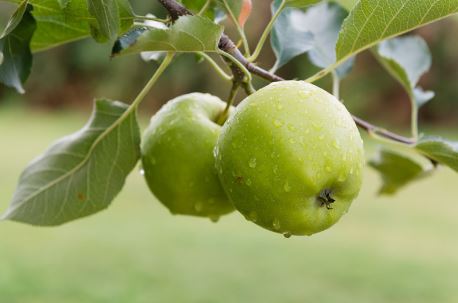
Granny Smith apples, botanically classified as Malus domestica, are bright green, tart fruits belonging to the Rosaceae family. Granny Smith apples originated in Australia in 1868. They are named after Maria Ann “Granny” Smith, who propagated the cultivar from a chance seedling. The story goes that she was testing different types of apple seedlings for cooking, and from one of these, the Granny Smith apple was born. It’s believed to be a hybrid of the European wild apple with the domestic apple.
Granny Smith apple trees can grow quite large if not pruned, typically reaching heights of 15 to 20 feet (4.5 to 6 meters) in standard form. They have a spreading, somewhat open canopy. The leaves are typical of apple trees, being broad, oval, and dark green, with serrated edges. In autumn, they can turn yellow or brown before falling. The trees produce white or pinkish-white blossoms in the spring, which are not only beautiful but also attract pollinators like bees.
Granny Smith apples were introduced commercially to the United Kingdom in the 1930s and later to the United States in the 1970s and were one of the first varieties exported globally for sale in supermarkets. Today Granny Smith apples are grown in Australia, Europe, New Zealand, South America, and the United States (particularly in states like Washington and California) and can be widely found through farmer’s markets and commercial retailers worldwide.
Granny Smiths are round, though they can be slightly flattened at the top and bottom. They tend to have a symmetrical shape. They have a bright green skin. This green can sometimes have a slight yellow tinge when the apple is very ripe, but it generally maintains a uniform green color. If you look closely, you’ll notice small speckles or dots on the skin. In colder climates, the apples may also develop a yellow to pink blush.
Underneath the surface, the white flesh is dense, crisp, and mildly aqueous. When you bite into one, it provides a satisfying crunch. This texture holds up well in cooking, which is why Granny Smiths are often chosen for baking where you want the apple pieces to retain some shape and not turn to mush. These apples are quite juicy. The juice is tart and can be somewhat acidic.
When cut or bitten into, Granny Smiths release a fresh, slightly sharp aroma and like many apples, the flesh will start to oxidize and turn brown when exposed to air.
Granny Smith apples pair well with sharp cheeses such as blue, feta, and gorgonzola, meats such as poultry, pork, and beef, arugula, spinach, potatoes, beets, and fruits such as banana, citrus, and pineapple.They are low in calories, high in fiber, and contain vitamins like Vitamin C, though not as much as some other fruits. They also have antioxidants and are good for digestion.
Cultivation of Granny Smith
Growing Conditions
- Climate: They thrive in temperate climates with cold winters and warm summers. They require a certain amount of chill hours (hours below 45°F or 7°C) to break dormancy and produce fruit. This makes them suitable for regions with distinct seasons but not ideal for tropical or extremely cold climates.
- Soil: They prefer well-drained, loamy soil with a slightly acidic to neutral pH. Good drainage is crucial to prevent root diseases.
- Watering: Regular watering is necessary, especially during dry spells, but overwatering should be avoided to prevent root rot.
- Pollination: Granny Smith trees are not self-fertile, meaning they require cross-pollination from another apple variety that blooms at the same time. Suitable pollinators include Golden Delicious, Fuji, or Gala apples.
Care
- Pruning: Annual pruning is essential to remove dead or diseased wood, improve air circulation, and shape the tree. This also helps in managing fruit load to prevent branches from breaking under the weight.
- Pests and Diseases: Like all apple trees, Granny Smiths are susceptible to pests like aphids, apple maggots, and diseases like apple scab and fire blight. Regular monitoring and appropriate organic or chemical treatments might be necessary.
- Harvesting: The apples are ready for harvest in late autumn. They should be picked when they’re fully colored but still firm. Overripe Granny Smiths might lose some of their characteristic tartness.
Propagation
- Grafting: Most Granny Smith trees are not grown from seed due to variability in seedling traits. Instead, they are propagated through grafting onto rootstocks, which can influence the tree’s size, disease resistance, and fruit-bearing age.